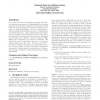Free Online Productivity Tools
i2Speak
i2Symbol
i2OCR
iTex2Img
iWeb2Print
iWeb2Shot
i2Type
iPdf2Split
iPdf2Merge
i2Bopomofo
i2Arabic
i2Style
i2Image
i2PDF
iLatex2Rtf
Sci2ools
ATAL
2005
Springer
2005
Springer
Multiagent simulation of learning environments
One of the key issues in designing appropriate and effective learning environments is understanding how learners advance and what factors contribute to their progress. This holds true for both human and machine learning environments. In Artificial Intelligence, there is a long tradition of studying human skill acquisition in order to design intelligent agents that learn. Using insight gained from analyzing co-evolutionary machine learners, we have been experimenting with human learning environments by simulating the interactions in a classroom. Here we detail our classroom model, formulated as an electronic institution. We describe the types of interactions that can occur between agents bearing one of two roles – teacher or student – and define a dialogic framework and a performative structure for these agents. We share the results of simulation experiments, demonstrating how particular sets of interaction rules can correspond to certain styles of human teaching and learning. C...
ATAL 2005 | Effective Learning Environments | Learning Environments | Machine Learning Environments |
| Added | 26 Jun 2010 |
| Updated | 26 Jun 2010 |
| Type | Conference |
| Year | 2005 |
| Where | ATAL |
| Authors | Elizabeth Sklar, Mathew Davies |
Comments (0)

